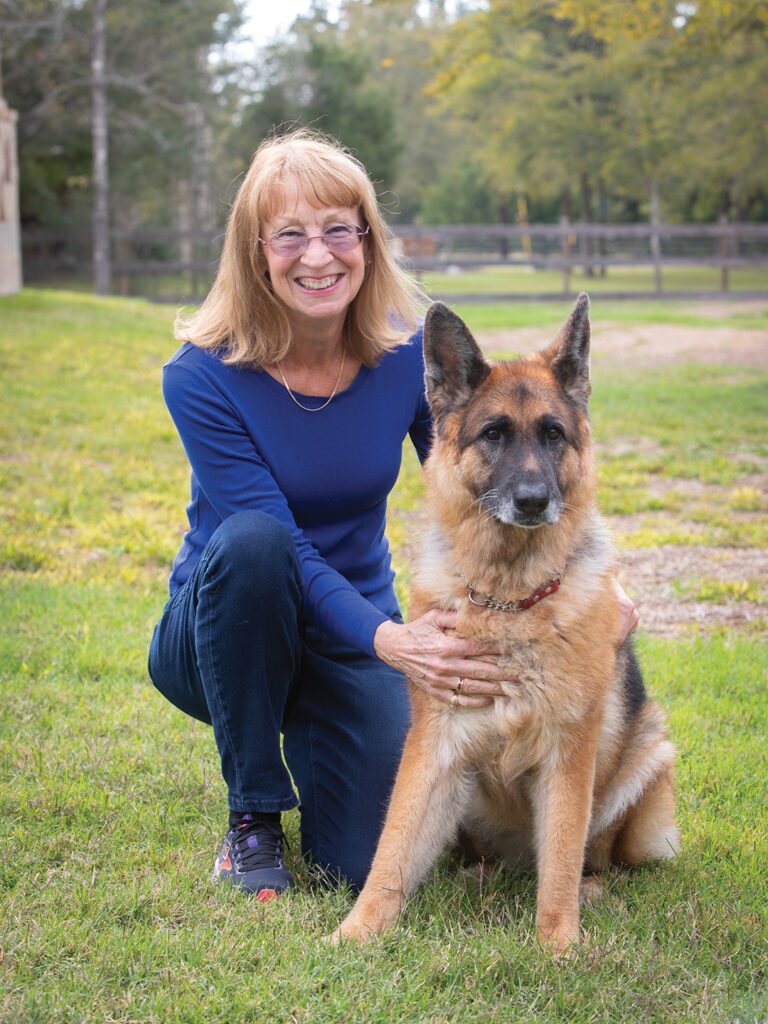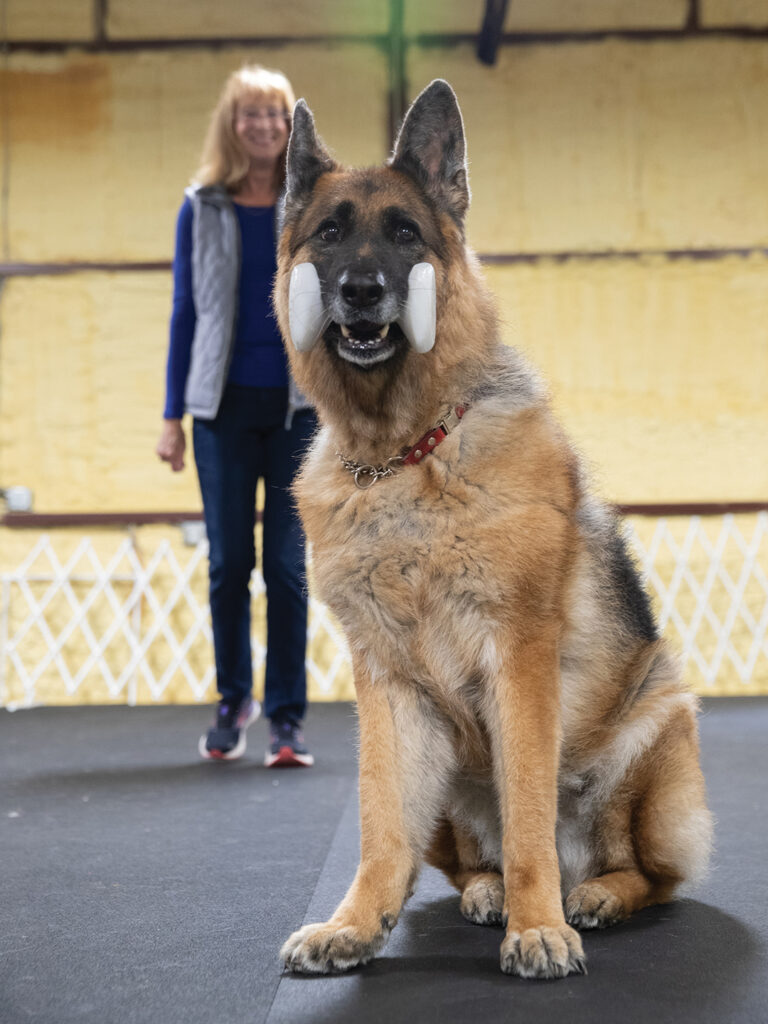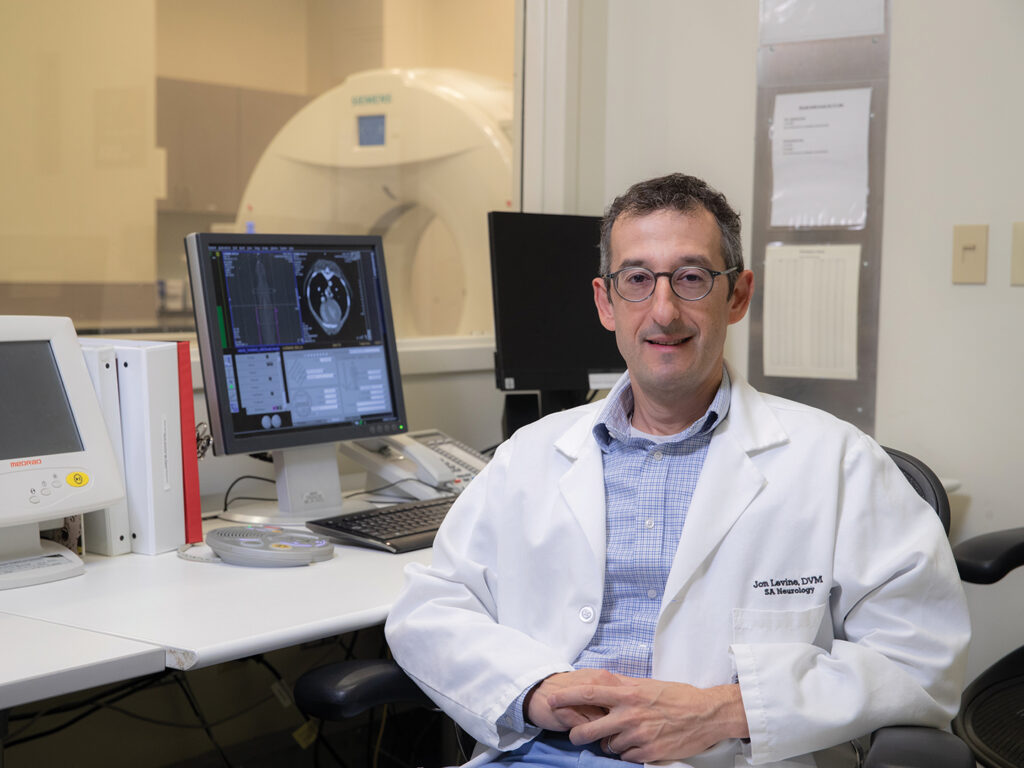Texas A&M Faculty Member, Former Student Team Up In Fight Against Cancer
Story by Dorian Martin

Susan Fontaine’s life-long love affair with dogs grew by leaps and bounds when she and her husband, George Corolla, started competing and showing their dogs in the early 1990s. Since then, the couple competed with six different dogs, all with names that started with an “M.”
Yet, as is the case with all pets, the Fontaine-Corollas’ dogs have faced health challenges over the years.
One of their most recent dogs, Murphy, wasn’t feeling well in 2017, so Susan took him to the veterinarian. Noticing a large lump in his throat, the veterinarian directed Susan to the Texas A&M Small Animal Teaching Hospital (SATH), where the German shepherd was diagnosed with lymphoma.
Murphy benefitted from the compassionate care of SATH’s staff as well as regular chemotherapy, which not only prolonged his life for three more years but also sustained his energy levels. He was still competing until two months before his death.
While the Fontaine-Corollas previously made gifts to the School of Veterinary Medicine & Biomedical Sciences (VMBS), the quality of care Murphy received during the last part of his life prompted Susan ’77 to establish the Susan Fontaine Endowment for Veterinary Clinical Trials, which will support research aiming to better both animal and human lives.
“We don’t only aspire to have research that directly impacts veterinary medicine, but we’re also very interested in human and environmental health,” said Dr. Jon Levine, head of the VMBS’ Small Animal Clinical Sciences Department (VSCS). “We know that dogs and cats — but especially dogs — have a lot of diseases that are very similar to people, whether we’re talking about cancer, Alzheimer’s disease, or some heart diseases. Information we can find out genetically about how a dog’s cancer develops might be very relevant to human cancers.”
Showing Off
The couple’s entry into dog competitions began when they lived in Seattle and brought home Molly, a German shepherd, in the early 1990s.
“We signed up for obedience school and the obedience instructor said, ‘You ought to consider competing and showing the dog,’” Susan said. “I never had thought about what that life was like and it hadn’t occurred to me that there was even such a thing as obedience competitions.”
Susan and Molly’s first competition proved to be a learning opportunity.
“We went into the ring and then Molly left me — she was supposed to stay with me — and she went and sat in the middle of the ring and watched me perform to the judges’ commands,” she said, laughingly.
The experience, however, caused her competitive juices to kick in.
“I’m going to prove I can do this,” she said. “This dog and I are going to conquer this; that got me hooked on competing with dogs.”
A year later, the Fontaine-Corolla family got another German shepherd, Max, which George decided to show while Susan showed Molly.

“It was a nice hobby we could do together,” Susan said. “We’d go to dog shows on the weekend and to class together. We’d do little workouts in our driveway in our neighborhood.”
Susan, who has also competed in rally and agility, believes dog competitions are a team sport.
“When the dog does well and you do well, there is no better feeling in the world. It is such a partnership with the dog; it’s like you’re in sync, so that’s the driving force of the competition,” she said. “Right now, with Mia, I’m doing nose work, which is scent detection that uses the dog’s natural ability to find a specific odor that’s hidden away. Mia has to communicate to me where it is and then I tell the judge. I’m right or wrong, based on what the dog has said to me.”
The couple was so committed to competing that, upon moving to College Station for retirement, they built a facility in their backyard so they could train locally instead of driving to Houston.
“I have a group of friends who come to do training together, but it’s not a business,” Susan said. “We support each other in our training efforts.”
Breaking Barriers
Susan’s ability to forge strong relationships was strengthened by her time as a student at Texas A&M. She came to campus right as women were being accepted into the Corps of Cadets and could live on-campus in dorms.
“There were four men to every woman, and there were around 18,000 students when I graduated,” she remembered. “It was very different than it is today.”
Her father was serving in the military and her family was stationed overseas when she enrolled at Texas A&M.
“I fit into the military culture; it was a family environment. I met really, really good friends with whom I’m still friends as we come up on our 45th class reunion,” she said. “I share my football tickets with my college roommate.”
After earning her degree, Susan stumbled into what turned into a 38-year career in the insurance industry, starting as an underwriting trainee at Aetna in Houston.
“It was a perfect fit for me. It’s very analytical and you get to learn a lot about a lot of different businesses,” she said. “It’s part psychologist, part detective, part actuary, and part fortuneteller—you try to predict who’s going to have a loss or a claim and what can you do to avoid that.”
Her work led to an introduction to her future husband and allowed the couple to live in Seattle and Wilmington, Delaware. As the couple neared retirement, they decided to look for a single-level home in a place with mild winters.
George, who wasn’t an Aggie, said, “What’s wrong with Bryan-College Station?” Noting that she was shocked that it was George’s idea, Susan explained about their decision to move to College Station in 2014, “I think he knew that I would be happy here. I’d brought him to a couple of reunions.”
Looking back over the years, Susan realizes that she entered both Texas A&M and the corporate world during a time of tremendous cultural change.
“It was the time period when women were coming to the workforce — and it was the same thing in my career,” she said. “I was the first commercial female manager for one of my insurance companies and the first female divisional president for another. I didn’t break the glass ceiling, but I knocked on it.”
Collaborative Partnership

Over the years, the couple lavished their attention on their dogs: Molly, Max, Missy, Moses, Murphy, and Mia.
“It started happening with Molly and Max, so when we got the next one, their name had to start with an ‘M,’” Susan explained.
With no children, the couple started considering how they wanted to distribute their estate — and both Texas A&M’s former College of Liberal Arts (which joined the new College of Arts and Sciences on Sept. 1) and the VMBS made their initial list, leading to liberal arts scholarships and supporting VMBS’ facilities.
Yet, Murphy’s experience with the SATH had a significant influence on Susan’s future funding decisions.
“I’ve always loved dogs, but I had not connected with the vet school when I was in college,” she said. “After watching Murphy’s experience, I thought that the school would be a good investment in the future.”
After George died in 2021, Susan learned that she received an inheritance that allowed her to do more for Texas A&M.
“I don’t have to live off of my income anymore,” she explained. “I realized that I had money to play with and to do good with that I didn’t have before — so what can I do?”
After reviewing options with the Texas A&M Foundation’s VMBS development team, Susan came up with a plan for her investment.
“The clinical trial idea jumped right out at me because I had been thinking all along, ‘What else can I do to help other dogs not go through what Murphy went through?’” she said.
Soon after, she read about Levine’s research on glioblastoma, a type of brain cancer that affects humans and dogs. Levine noted that other VMBS researchers are studying conditions that could have implications for human beings, including Chagas disease and cartilage replacement, as well as the dog aging process.
Levine is already putting Susan’s endowment to work.
“Our immediate use for this is to help support a start-up package for a geneticist we are hiring,” he said, adding that this position, which also incorporates funding from the Office of the Provost, will be a joint hire between VSCS and the VMBS’ Department of Veterinary Pathobiology. “The idea behind this strategy is to amplify the collaborations we have. This geneticist will be a benchtop scientist who works with test tubes and looks at genetic data but also can connect with the faculty members who see cases in the trenches and identify new or current diseases that we don’t understand.”
Susan hopes that more donors will consider supporting these types of innovative efforts to improve the health of both dogs and human beings.
“I’m an ordinary person. I remember the days when I had to buy clothes on layaway and not buy groceries until I got my paycheck,” Susan said. “I think anybody can give — and anybody can plan to give in the future. You have to make it part of your values.”
###
Note: This story originally appeared in the Winter 2023 edition of VMBS Today.
For more information about the Texas A&M College of Veterinary Medicine & Biomedical Sciences, please visit our website at vetmed.tamu.edu or join us on Facebook, Instagram, and Twitter.
Contact Information: Jennifer Gauntt, Director of VMBS Communications, Texas A&M College of Veterinary Medicine & Biomedical Sciences; jgauntt@cvm.tamu.edu; 979-862-4216


